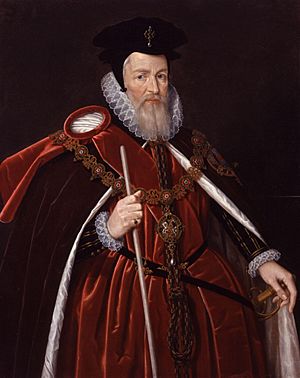Secretary of State (England) facts for kids
Quick facts for kids EnglandSecretary of State |
|
|---|---|

Coat of Arms of the Kingdom of England from 1603 to 1649
|
|
| Member of | Privy Council |
| Seat | Westminster, London |
| Appointer | The English Monarch |
| Term length | No fixed term |
| Formation | 1253–1645 |
| First holder | John Maunsell |
| Final holder | George Digby, 2nd Earl of Bristol |
In the old Kingdom of England, the job title of Secretary of State started to be used around the end of Elizabeth I's time as queen. Before that, people holding this important role were usually called the King's Clerk, King's Secretary, or Principal Secretary.
From the time of King Henry VIII, there were usually two secretaries. After the monarchy was brought back in 1660, these two jobs were specifically named the Secretary of State for the Northern Department and the Secretary of State for the Southern Department. Both of them handled matters inside England. They also split up the work related to other countries.
Contents
Understanding the Secretary of State Role
Long ago, the kings of England had a special helper who was often a church official. This person was first known as their Clerk, and later as their Secretary. Their main job was to manage the king's official letters and messages.
But this role was more than just writing letters. The secretary also gave advice to the King or Queen. By the early 1300s, this position had become one of the three most powerful jobs in England. It was only less powerful than the Lord Chancellor.
Most of the government's daily work happened through the royal household. This included a special department called the Wardrobe. The number of official documents needing approval grew quickly in the late Middle Ages.
A special stamp, called the Signet warrant, was used to approve documents. The person in charge of this was the Secretary. They often went on important trips for the king, like military missions or talks with other countries.
How the Role Changed Over Time
Until King Henry VIII ruled (1509–1547), there was usually only one secretary. But by the end of his reign, a second secretary was added. Around the end of Queen Elizabeth I's reign (1558–1603), these secretaries started to be called "Secretary of State."
After the monarchy was restored in 1660, the two secretary jobs got specific names. They became the Secretary of State for the Northern Department and the Secretary of State for the Southern Department. Both secretaries handled matters within England. They also divided up foreign affairs. One dealt with countries in northern Europe, mostly Protestant ones. The other handled countries in southern Europe.
After the Glorious Revolution in 1688, the Cabinet started making more of the important decisions. Before this, the Privy Council had done more of this work. Because of these changes, the two secretaries of state gained even more power and responsibility.
Key People Who Held the Office
Here are some of the important people who served as Secretary or Secretary of State in the Kingdom of England:
- John Maunsell (1253–1263?)
- William of Wykeham (1360)
- John Profit (1402–1412)
- Thomas Beckington (1439–1443)
- Richard Foxe (1485–1487)
- Thomas Cromwell (April 1534 – April 1540)
- Sir William Cecil (served Queen Elizabeth I)
- Sir Francis Walsingham (served Queen Elizabeth I)
- Sir Robert Cecil (July 1596 – 1612)
- Sir Ralph Winwood (1614 – 1617)
- Sir George Calvert (1619 – 1625)
- Sir Edward Nicholas (1641 – 1646, and again 1654 – 1662)
- George Digby, 2nd Earl of Bristol (1643 – 1645)
Commonwealth and Protectorate Secretaries
During the time when England was a Commonwealth (without a king), these individuals held similar roles:
- Thomas Scot (July 1649 – April 1652)
- John Thurloe (April 1652 – May 1660)
For the secretaries who served after England and Scotland joined together in 1707, you can look at:



